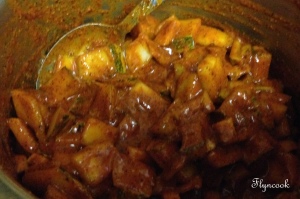Like most green leafy vegetables, Amaranth leaves are rich in vitamins (A & C) and minerals such as potassium, iron, calcium and folate. They can be commonly found in tropical and warm temperate regions of the world and go by different names depending on region. In Andhra Pradesh they are commonly known as Thotakura. Unlike Red Sorrel (Gongura) leaves, Amaranth leaves don’t have a tart flavor. We most commonly made dal or pulusu (a tangy stew with tamarind juice).
For the dal:
1/2 bunch amaranth leaves
1 cup toor dal (pigeon peas)
2-3 tbsp tamerind juice
4-5 garlic cloves, peeled and sliced (if large)
1 jalapeno sliced
a few curry leaves
1/2 tsp red chili powder
1 tsp oil
1 tsp mustard seeds
1 tsp cumin seeds
1-2 dry red chili
pinch of turmeric
pinch of asafoetida
cilantro to garnish
 Stew Ingredients:
Stew Ingredients:
1/2 bunch amaranth leaves
1/2 small bottle gourd peeled and chopped
1 jalapeno sliced
4-5 garlic cloves, peeled and sliced
a few curry leaves
1 tbsp sesame seeds (or powder)
1/2 tsp red chili powder
2 tsp rice flour
1 tsp oil
1 tsp mustard seeds
1 tsp cumin seeds
1-2 dry red chili
1tsp urad dal
a pinch of turmeric
a pinch of asafoetida
To make the dal, cook toor dal with two cups of water in a bowl stove top or typically I cook mine in a pressure cooker. Add half chopped amaranth leaves to a large pan, add some water and cook on medium for about 10 minutes, until the leaves wilt and cook. Lightly mash the cooked toor dal with a spatula and add to the bowl containing the amaranth leaves. Add 2-3 tbsp tamarind juice, salt and chili powder and mix well. Reduce flame and let simmer for 10-15 minutes.
Meanwhile, in a pan heat oil. Add turmeric, asafoetida, mustard and cumin seeds, red chilies, and sliced garlic and fry till lightly golden. Add curry leaves and sliced jalapeno and continue frying for another 3-4 minutes.
 Transfer to the dal bowl. Garnish with chopped cilantro and serve warm.
Transfer to the dal bowl. Garnish with chopped cilantro and serve warm.
To make the stew, cook amaranth leaves and chopped bottle gourd with some water in a bowl, until cooked. About 10-15 minutes. Add about 1 cup tamarind juice and mix well. Add salt and red chili powder and mix well. Let simmer on medium low for about 15-20 minutes. In a small bowl mix 2 tsp rice flour with some water and transfer the mix to the stew. This helps coagulate the stew. Simmer for another 5 minutes.
Meanwhile, heat a little oil in a pan. Add tumeric, asafoetida, sliced garlic, cumin and mustard seeds, urad dal and red chilies and fry till lightly golden. Add sliced jalapeno and curry leaves and fry for 3-4 minutes. Transfer to the stew bowl and mix well.
 Lightly toast sesame seeds till lightly golden. Grind to powder and add to the stew. Can used mustard powder instead of sesame. Mix well, garnish with chopped cilantro and serve warm with some rice. We typically ate the stew with some snake gourd cooked with moong dal or bottle gourd cooked with toor dal or pumpkin and chana dal or something similar.
Lightly toast sesame seeds till lightly golden. Grind to powder and add to the stew. Can used mustard powder instead of sesame. Mix well, garnish with chopped cilantro and serve warm with some rice. We typically ate the stew with some snake gourd cooked with moong dal or bottle gourd cooked with toor dal or pumpkin and chana dal or something similar.







![methi2]JPG](https://flyncook.files.wordpress.com/2014/05/methi2jpg.jpg?w=300&h=200)










